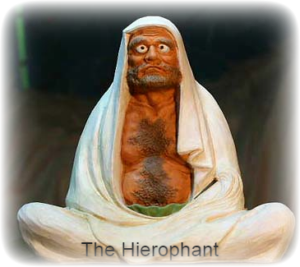Historically the Hierophant stands for wisdom and the ongoing strength and teaching of a living spiritual tradition. In our study it relates to mystical-spiritual respiration:
There are two kinds of respiration: horizontal respiration which takes place between “outside” and “inside”, and vertical respiration which takes place between “above” and “below”. The “sting of death” or the essential crisis of the supreme agony is the abrupt passage from horizontal to vertical respiration. Yet he who has learnt vertical respiration whilst living will be spared from this “sting of death”. For him the passage from the one form of respiration to the other will not be of the nature of a right angle but rather the arc of a circle. (MOTT)
This circular-arc is a never ending return to the Source (Mind Only) whilst simultaneously conquering the dominion of Mara’s death. Bodhidharma embodies this equation and within Ch’an/Zen Tradition he personifies one who has conquered the sting of death through Embryonic Breathing (Spiritual Respiration.) For a full study of Bodhidharma’s Teaching please read our series, The Zen Teaching of Bodhidharma. Now, our emphasis is upon that champion of the Prior-Breathing technique in Embryonic fashion.
Since the Chan Buddhist hagiographies suggest that Bodhidharma lived over 150 years and merely feigned his death, it is perhaps not surprising that he would be attributed with knowledge and mastery of an immortality method. He learned the technique before departing from China from a certain teacher named Baoguan…
Damo miaoyong jue begins with Bodhidharma reminiscing on how he had, before embarking on his journey to China from the “western land,” implored a certain teacher named Baoguan 寳冠to teach him a method by which he could avoid disease and death. Bodhidharma already had mastered his own “Secret Dharma of the Mind’s Ground” 心地密法, but knew that this alone conferred only spiritual enlightenment. Thus, in order for Bodhidharma to become an Immortal, he needed to have some sort of physical method by which to supplement it…
Baoguan starts out by emphasizing the importance of understanding the condition at the time of conception and gestation, when the fetus is utterly innocent and full of vitality, living off the qi that the mother breathes. Not long after birth the baby begins to smile and engage the outer world, and this initiates the loss of innocence and vitality. The mother is delighted at giving birth, but is sadly oblivious to the fact that she has lost an immense amount of vitality.
Baoguan thus points out that when one considers this great sacrifice made by one’s mother, one ought to understand why “our Śākyamuni Buddha” commanded people to love and respect their parents, and gratefully repay their debt to them.
The Embryonic Breathing method that Baoguan goes on to describe primarily involves calming the mind and focusing on the Sea of Qi (qihai 氣海) beneath the navel, so as to make spirit and qi merge harmoniously there. With sustained practice one can make the conjoined spirit and qi circulate and illuminate the body and its internal organs. One eventually can enter into a condition of “True Embryonic Breathing” (zhen taixi 真胎息) where breath no longer exits from the nose. (Stephen Eskildsen, Bodhidharma Outside Chan Literature: Immortal, Inner Alchemist, and Emissary from the Eternal Realm.)
Bodhidharma further expounded upon this Embryonic Breathing technique and became a great inner-alchemist. His own methodology employed the following:
“Always breathe (or repose?) at the wheel (cakra?) of the heart (or mind?) and thereby be unattached to the myriad things. If your qi is not stable, your meditation (chan; Sanskrit, dhyāna) is in vain. If your qi is stable, your body of form will be without illness, and chan (meditation; Chan Buddhism) and the Dao will both be secure. Practitioners, because they do not guard their hearts (or minds), lose their primal qi and do not gather it. How, then, can the Dao be accomplished?” (Damo taixi jue 5b–6a)
The sense conveyed is that mental concentration and trance are the domains of Chan Buddhism while qi and physical health are the domains of Daoism; thus Embryonic Breathing is the method that combines and satisfies the agendas of both traditions by bringing optimal, salubrious calm to both mind and body.
Damo taixi jue goes on to state:
A man of old has said, “When qi is stable, the mind is stable. When the qi congeals, the mind is still. This is the essence of the Great Way, and is also known as ‘the Recycled Elixir.’” A person of the Way should not encumber the mind with anything, and should be like this day after day. This is what is called the Meditative (Chan; dhyāna) Observation of True Absorption (samādhi). All virtuous sages of past, present and future cultivate based on this. This lesson is called “the Dual Cultivation of Meditative Absorption” (or perhaps, “the Dual Cultivation of Meditation and Absorption”) (Damo chanshi taixi jue 6a) [ibid]
Master Bodhidharma is here proclaiming that his “Embryonic Breathing method is the true Chan meditation that does in fact cultivate both innate nature and vitality, and that it is inner alchemy.” Bi guan is the proper starting point for such procedures as deep samadhis gives birth to the Bodhichild, who in turn is actually partaking in this embryonic breathing (see Spirit Breathing). The purpose here is to prevent any leakage of qi. This breathes new insight into his wall-technique, “If one can “face the wall for nine years without the slightest leakage of qi, “the Yin spirit will naturally exit”. Hence, Bodhidharma’s wall-gazing is in reference to the transference of qi. Also, remember, one needs to learn to see like a wall sees—Unmoving and undisturbed—NOT as a mind “perceiving” the wall!
We also should bear in mind that for Ch’an adepts, Bodhidharma’s significance is just as great as Padmasambhava is to the Tibetans. He IS our Hierophant—the one who is the very guardian of this spiritual respiration…the auspicious Godfather of the Bodhichild.

